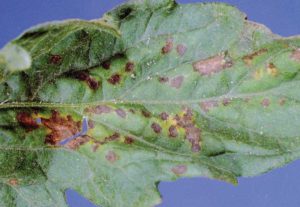
It’s become a full time job to keep up with all the great research articles that are being produced these days! Often, we find articles related to our specific solutions such as combating bacterial spot in tomatoes! We may not have been included in this particular trial but have outstanding results with bacterial spot as you can see in our research trials – Click here to view Information Sheet!
You may have seen this article written by Gene McAvoy for Florida Grower magazine.
Bacterial spot is caused by several species of Xanthomonas spp. Four species have been identified on tomato: X. euvesicatoria, X. vesicatoria, X. perforans, X. gardneri. In Florida, the major species encountered is X. perforans.
Symptoms of bacterial spot appear as small, water-soaked, greasy spots on infected leaflets. On tomatoes, distinct spots with or without yellowing occur. Individual leaf spots may coalesce with each other, resulting in the browning of entire leaflets. Fruit spots often begin as dark specks with or without a white halo. As spots enlarge, they become raised and scab-like.
Survival and Spread
X. perforans is seed-borne, which allows strains to move on a global scale.
At the field level, most inocula comes from infected transplants, volunteer plants, or infected plant debris in the soil. Entry into the plant occurs through stomata, or wounds made by wind-driven soil, insects, or cultural operations. Temperatures of 75°F to 87°F are ideal for bacterial spot, but infections can occur at higher or lower temperatures.
Management Methods
An integrated approach is needed to manage this disease. No resistant tomato varieties are available commercially.
Exclusion is the best means of managing bacterial spot on tomato. Unfortunately, even the best bactericidal treatment offers only limited protection when environmental conditions are favorable for rapid disease development, especially during periods of heavy, wind-driven rains.
Sanitation is important. Pepper and tomato volunteers and solanaceous weeds should be destroyed between crops. Purchase only certified, disease-free transplants and seed.
Infected transplants can provide for long-distance transplant of the disease. To reduce the incidence of disease, transplant houses should be located away from tomato or pepper fields. Inspect transplant trays every daily for signs of disease and rouge out and destroy trays at the first sign of disease. Transplant house workers should wash and sanitize their hands frequently to avoid bacteria moving from tray to tray and house to house.
Since water movement spreads the bacteria from diseased to healthy plants, workers and farm equipment should be kept out of fields when fields are wet, because the disease will spread readily under wet conditions.
The traditional recommendation for bacterial spot control consists of copper and maneb or mancozeb. The effectiveness of copper is limited because of the widespread occurrence of copper tolerance among strains of Xanthomonas.
In replicated trials at UF, two products, Actigard (acibenzolar-S-methyl, Syngenta) and Cueva (copper octanoate, Certis), consistently performed better in managing bacterial spot over standard applications of copper hydroxide in repeated trials when treated alone or combined with other products.
It is important to apply sprays before and during rainy periods. If conditions are favorable, frequent spraying may not be sufficient to maintain bacterial spot below damaging levels.
Consult UF/IFAS recommendations for formulations, rates, and intervals of currently labeled materials for bacterial spot in Florida.
This is a great article written by Gene McAvoy is the Associate Director of Stakeholder Relations for the UF/IFAS Southwest Florida Research and Education Center in Immokalee, FL.
However, we wanted to make sure you were aware of a new tool to add to your arsenal! If you have been some of the shows such as The Florida Ag Expo, The Southeastern Regional Fruit & Vegetable Conference or CAPCA; you may have heard us discuss Magna-Bon CS 2005 research trials of by Dr. Manuel Huerta Lara from University of Puebla on bacterial spot.
In Dr. Lara’s 1st Assessment of Application, the tomato plant had a rate of 27% Control. With 2.5 ml/L of CS 2005 had 95% control of the infection! In the 2nd Assessment, again 2.5 ml/L of CS 2005 was applied and received an almost 97% control of bacterial spot! What more could you ask for? An environmentally friendly OMRI-listed copper sulphate pentahydrate to help you control disease in tomatoes. Just in case you missed it above, Click Here To read the Full Research Trials by Dr. Manuel Huerta Lara…

